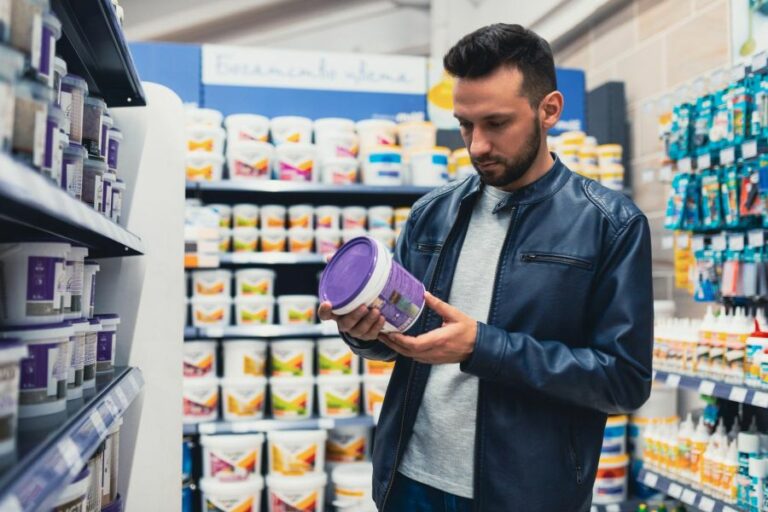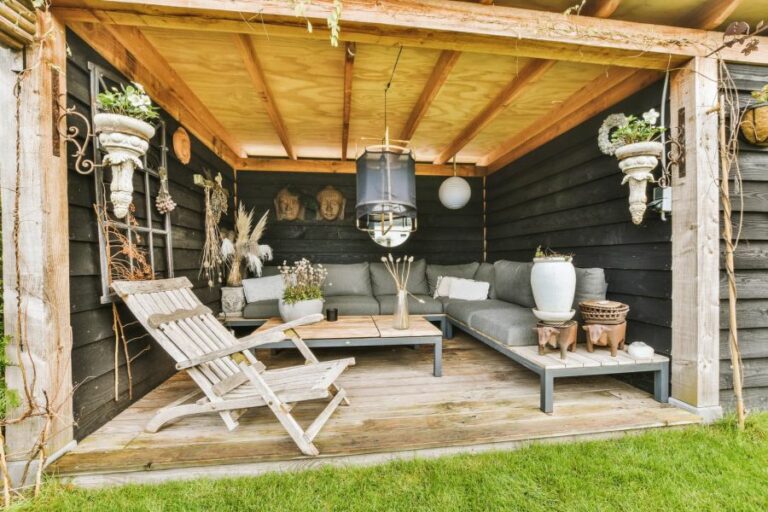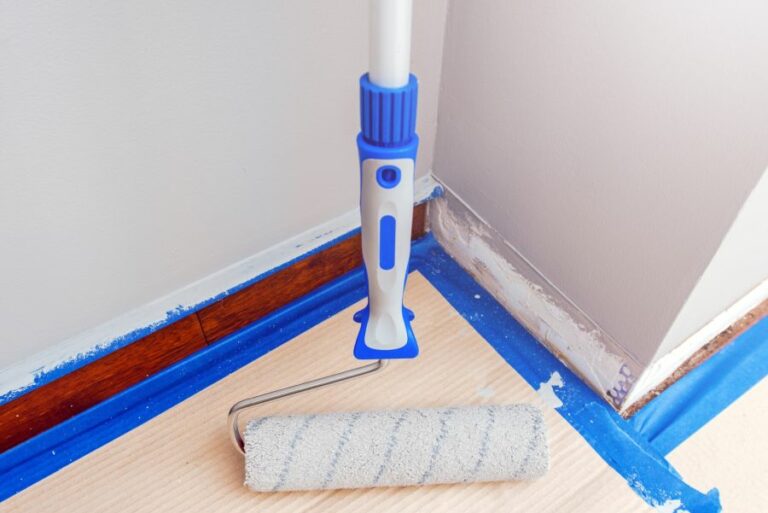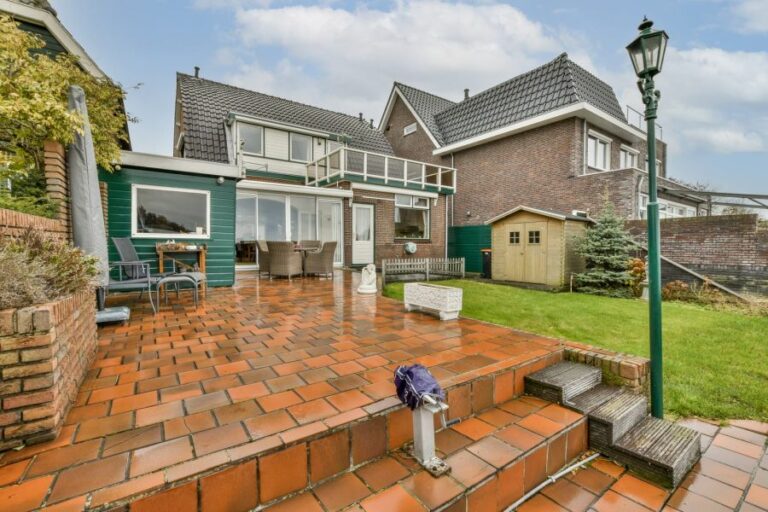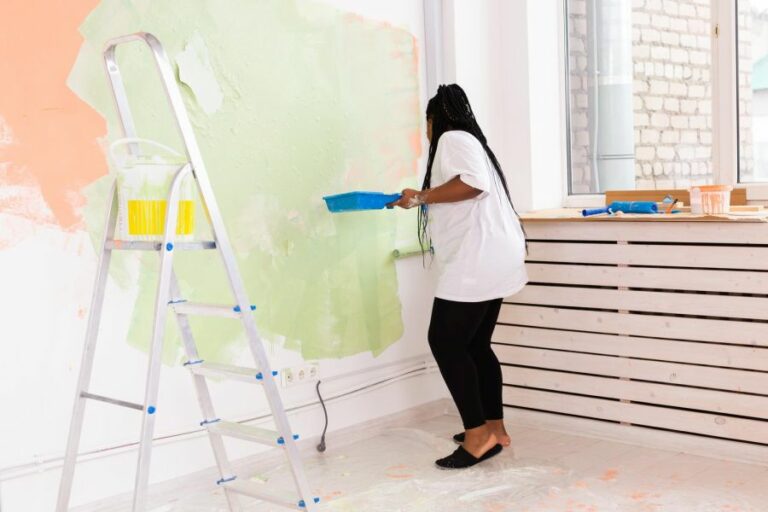Ready for a Refresh? Try These Outdoor Floor Paint Ideas
Transform your outdoor oasis with stunning, resilient, and eye-catching floor paint ideas to elevate your curb appeal to a new level. Discover various versatile designs and innovative color options, from vibrant patterns to neutral shades, to suit your style preferences and enhance your outdoor space.
Outdoor floor paint ideas:
This comprehensive guide explores outdoor floor painting ideas, including epoxy paint for a durable and stylish finish, concrete stain for a natural appearance, acrylic paint for affordability and creativity, and textured paint for enhanced traction and beauty.
When choosing the right outdoor floor paint, consider budget, personal preferences, and the area’s primary use. Always follow the manufacturer’s instructions and take appropriate safety precautions when applying paint.

Explore the world of vibrant, durable outdoor floor paints as I guide you through various design ideas and application techniques. Transform your patio, terrace, or garage space into a masterpiece with colors that suit your unique style!
Contents
- 1 Creative Outdoor Floor Painting Ideas for Exterior Spaces
- 2 What is the Optimal Exterior Floor Paint for Outstanding Results?
- 3 What is the Optimal Floor Paint for Exterior Concrete Surfaces?
- 4 Which Colors are Most Suitable for Outdoor Patio Flooring?
- 5 Is it Possible to Apply Paint on an Outdoor Concrete Floor?
Creative Outdoor Floor Painting Ideas for Exterior Spaces
Outdoor spaces are essential in our lives as they provide a place to relax, entertain, and enjoy beautiful natural surroundings. A well-maintained outdoor space, whether a porch, patio, or backyard, adds value, aesthetic appeal, and functionality to our homes.
One of the most effective ways to enhance the beauty and comfort of an outdoor living area is by selecting the appropriate outdoor floor paint. We will explore various outdoor floor paint ideas and their pros, cons, and best practices when applying them.
• Epoxy Paint: A Durable and Stylish Option
Epoxy paint is a reliable choice for outdoor flooring due to its durability, resistance to weather, and overall aesthetics. This two-component paint forms a hard, glossy finish perfect for residential and commercial settings.
Epoxy paint is available in various colors and can be customized with decorative flakes or tints.
– Pros
- Long lifespan
- Resistant to weather, chemicals, and abrasions
- Easy to clean and maintain
- Available in a variety of colors
– Cons
- Can be slippery when wet
- Requires thorough surface preparation
- Application process can be time-consuming
– Recommendations
Before applying epoxy paint, ensure the surface is clean, dry, and free of grease or oil. Following the manufacturer’s instructions for the correct mix ratio and curing time is vital. Always wear proper protective gear when handling epoxy paint.
• Concrete Stain: A Natural and Elegant Look
Concrete staining is an exceptional option for those who prefer a more organic and natural look to their outdoor flooring. By reacting with the concrete’s minerals, concrete stain creates unique patterns and hues, resulting in an elegant and timeless finish.
– Pros
- Creates a natural appearance
- Fade-resistant and long-lasting
- Can be used on both new and old concrete surfaces
– Cons
- Limited color choices
- Surface flaws may remain visible
- Outdoor stains require a sealer for added protection
– Recommendations
When applying a concrete stain, start by thoroughly cleaning and etching the surface of the concrete. This will allow the stain to penetrate the surface better. Apply multiple coats of stain for more vibrant color.
Always seal the stained surface with a clear sealer to ensure longevity and protect it from outdoor elements.
• Acrylic Paint: An Affordable and Creative Choice
Acrylic paint is a versatile and budget-friendly option for outdoor floor painting, suitable for various surfaces, including wood, concrete, and stone. Acrylic paint is available in various colors, allowing for creativity and personalization in your outdoor flooring.
– Pros
- Cost-effective
- Suitable for multiple surfaces
- Available in a wide range of colors
– Cons
- Less durable than epoxy or concrete stains
- May require multiple coats
– Recommendations
Before applying acrylic paint, ensure the surface is clean, dry, and primed. Priming the surface allows for better paint adhesion and a smoother finish. Apply multiple thin coats, allowing each coat to dry before adding the next.
Consider sealing the surface with a clear sealer for added protection.
• Textured Paint: Enhanced Traction and Beauty
Textured paint, or anti-slip or non-slip paint, is perfect for outdoor areas prone to moisture or slippery conditions. These paints contain additives, such as sand or rubber particles, providing a textured finish that improves traction and adds a decorative element to the surface.
– Pros
- Improves traction on slippery surfaces
- Can be used on various surfaces
- Available in a variety of colors
– Cons
- May be difficult to clean
- Surfaces may feel rough underfoot
– Recommendations
Clean the surface thoroughly before applying textured paint, ensuring no dirt, debris, or mildew. For best results, use a paint roller with a long handle that can reach all areas of the surface. Apply multiple thin layers, allowing drying time between each layer.
• Final Thoughts
Choosing the right outdoor floor paint can enhance the beauty of your outdoor living space and improve its durability and safety. Consider your budget, personal preferences, and the area’s primary use when deciding.
Always follow the manufacturer’s instructions and take appropriate safety precautions when applying outdoor floor paint.
Idea | Description |
|---|---|
Checkerboard Pattern | Create a classic checkerboard pattern using two contrasting colors: black and white or navy and white. |
Geometric Designs | Use stencils, tape, or freehand to create intricate geometric patterns using a variety of colors for a unique and eye-catching design. |
Faux Stone | Paint a faux stone finish on your outdoor floor with multiple shades of color to create the illusion of textured stone. |
Concrete Stain | Apply a pigmented concrete stain to your outdoor floor, then use a brush or sponge to create subtle variations in color and texture. |
Stencil Over Solid Color | Apply a solid color of paint to your outdoor floor, then use a stencil to add patterns, borders, or even words with a contrasting color. |
Faux Brick | Paint a faux brick pattern on your outdoor floor using brick red paint, and add highlights and shadows with shades of gray and white for a realistic effect. |
Mosaic | Create a colorful mosaic pattern on your outdoor floor by painting small squares, circles, or other shapes in various colors, then arrange them in a pleasing pattern. |
What is the Optimal Exterior Floor Paint for Outstanding Results?
Choosing the right paint to use on outdoor floors can be a challenging task. There are various factors to consider, including durability, safety, appearance, and cost. This guide will help you understand the different types of outdoor floor paint available and their benefits to make an informed decision.
• Types of Outdoor Floor Paint
– Acrylic Latex Floor Paint
Acrylic latex floor paint is one of the most popular choices for exterior surfaces due to its durability, affordability, and ease of application. This water-based paint is easy to clean and maintain and dries relatively quickly compared to oil-based paints.
Acrylic latex paint is also resistant to fading, peeling, and mildew.
– Epoxy Floor Paint
Epoxy floor paint is a durable and hard-wearing option for commercial and industrial applications. Epoxy paint is a two-part system consisting of a resin and a hardener that, when mixed, creates a tough and long-lasting surface.
Epoxy floor paint is resistant to moisture, chemical spills, and heavy foot or vehicle traffic. However, applying it can be more challenging and may require professional installation.
– Concrete Floor Paint
Concrete floor paint is specifically formulated on driveways, patios, and sidewalks. This type of paint is designed to penetrate and bond with the concrete, providing a durable and weather-resistant finish.
Concrete floor paint is available in water- and oil-based varieties, with the former being easier to clean up and offering a lower odor.
– Anti-Slip Floor Paint
Safety is crucial when choosing outdoor floor paint, especially for surfaces that can become slippery when wet. Anti-slip floor paints are formulated with additives that create a textured, slip-resistant surface. These paints are ideal for walkways, steps, pool decks, or slippery outdoor flooring.
• Factors to Consider When Choosing Outdoor Floor Paint
– Durability
Outdoor floors are exposed to various elements, such as sunlight, rain, snow, and chemicals. It’s essential to choose a paint that can withstand these conditions without fading, peeling, or chipping to ensure the longevity of the painted surface.
– Safety
Slippery surfaces can lead to accidents and injuries, making it crucial to prioritize safety when choosing outdoor floor paint. Opt for paint with anti-slip properties, or consider adding a slip-resistant additive to minimize the risk of slip-and-fall incidents on your outdoor surfaces.
– Appearance
While the durability and safety of your outdoor floor paint are important factors to consider, you should not overlook the visual appeal of the paint. Select a color and finish that will enhance your outdoor space’s appearance and complement your property’s overall design and aesthetics.
– Preparation and Application
Proper preparation and application are vital for the success and longevity of your outdoor floor paint. Follow the manufacturer’s instructions for surface preparation, including cleaning and repairing any cracks or damage.
Additionally, consider the application process and whether professional installation may be necessary, especially when working with specialized paints such as epoxy.
– Cost
Finally, keep in mind the cost of outdoor floor paint when making your decision. While it may be tempting to choose the cheapest option available, it’s important to consider the long-term value and durability of the paint.
Investing in high-quality paint may be more expensive upfront, but it can save time and money on maintenance and repairs in the long run.
• Recommended Outdoor Floor Paints
Based on the factors mentioned above, the following paints are highly recommended for outdoor flooring applications:
- Acrylic Latex Floor Paint: For general use on various exterior flooring surfaces, high-quality acrylic latex paint offers an excellent balance of affordability, durability, and ease of application. I recommend the [insert brand here] as a top choice for its long-lasting finish and superior weather resistance.
- Epoxy Floor Paint: For commercial or industrial applications requiring a durable, heavy-duty surface, epoxy floor paint is your best bet. Consider the [insert brand here] for its superior durability and impressive resistance to chemicals, moisture, and abrasion.
- Anti-Slip Floor Paint: For safety-conscious property owners, slip-resistant paint is a must. The [insert brand here] provides an excellent combination of durability and slip resistance, making it an ideal choice for outdoor walkways, steps, and pool decks.
In conclusion, finding the best outdoor floor paint for your specific needs requires careful consideration of durability, safety, appearance, application, and cost.
By considering these factors and using the recommendations provided, you can make an informed decision and achieve a long-lasting, attractive, and safe finish for your outdoor flooring surfaces.
Paint Brand | Type | Features |
|---|---|---|
KILZ | Over Armor Textured | Weather-resistant, slip-resistant, available in multiple colors |
Rust-Oleum | Deck & Concrete Restore | Water-based, durable, thick coating for wood and concrete |
BEHR | Premium Porch & Patio | Mildew-resistant, easy-clean finish, suitable for wood and concrete |
Insl-x | Sure Step Acrylic | Slip-resistant, waterproof, resistant to cracking |
Drylok | E1 Latex 1-Part | Waterproof, low odor, non-skid |
What is the Optimal Floor Paint for Exterior Concrete Surfaces?
Choosing the right floor paint for your outside concrete surface is vital for ensuring durability, longevity, and an appealing finish. With numerous options available in the market, finding the best option might seem daunting.
However, this comprehensive guide will help you decide based on your requirement, budget, and desired outcome.
• Factors to Consider When Choosing Outside Concrete Floor Paint
– Surface Preparation
The first and foremost factor to consider when selecting floor paint is the condition of the concrete surface. It should be clean, dry, and free of any dirt or debris. If you’re working on a new concrete surface, wait for at least 28 days for the concrete to cure before applying the paint.
For older surfaces, it’s essential to remove any old paint, oil stains, and dirt using a pressure washer or chemical-based cleaner.
– Weather Conditions
Consider the weather conditions of your area when choosing the right paint for your outside floor. Extreme temperatures, moisture, and heavy traffic can significantly impact the paint’s performance.
Always ensure to buy paint explicitly designed for the outside concrete floors, as they usually offer resistance to UV rays, water, and wear and tear.
– Desired Finish
Determine the type of finish you want for your floor matte, glossy, or semi-glossy. Each finish has pros and cons; therefore, selecting based on your preference and intended use of the area is vital.
– Coverage and Drying Time
Check the paint coverage and drying time before making a purchase. Various paints will have different coverage areas and drying times, so select the one that suits your requirements.
• Top Outside Concrete Floor Paint Options
– Epoxy-Based Floor Paint
I recommend epoxy-based floor paint due to its exceptional durability and moisture, chemicals, and heavy traffic resistance. Epoxy paints consist of a two-part system a resin and a hardener which, when mixed, create a solid bond with the concrete surface.
Additionally, epoxy paints are available in a wide range of colors, allowing you to choose a design that complements the surrounding area.
Pros:
- High durability and resistance to wear and tear, chemicals, and moisture
- Can be applied on various surfaces, including concrete, stone, and metal
- Available in various colors and finishes
- Easy to clean and maintain
Cons:
- Expensive compared to other options
- Requires a thorough surface preparation for optimal adhesion
- Longer drying time
- Can be slippery when wet; anti-slip additives can be used to address this issue
– Acrylic-Based Floor Paint
Acrylic paints are water-based and offer a cost-effective alternative to epoxy paints. They provide a decent balance between durability, adhesion, and resistance to UV rays and moisture. Acrylic paints are ideal for light to moderate traffic areas, making them popular for residential applications.
Pros:
- Affordable compared to epoxy paints
- Fast-drying properties
- Easy to apply and maintain
- Resistance to UV rays and mildew
Cons:
- Less durable compared to epoxy paints
- May require multiple coats for optimal coverage
- Not suitable for heavy traffic areas
– Polyurethane-Based Floor Paint
Polyurethane paints are known for their excellent resistance to UV rays and chemicals, making them an ideal choice for industrial applications. These paints have a higher solids content, resulting in a thicker coating that provides superior durability and protection than acrylic paints.
Pros:
- High resistance to UV rays, chemicals, and abrasion
- Excellent durability
- Versatile application, suitable for various surfaces
- Withstands extreme weather conditions
Cons:
- Expensive compared to acrylic paints
- Requires meticulous surface preparation for proper adhesion
- Longer drying time
• In Conclusion
The best floor paint for outside concrete ultimately depends on your specific requirements and the area’s intended use. If you desire high durability and industrial-strength protection and can afford a higher price tag, epoxy-based or polyurethane-based paint would be the best choice.
On the other hand, acrylic-based floor paint will be a suitable choice if you’re looking for a more affordable option with moderate durability and resistance to weather conditions.
Regardless of the type of paint you select, prioritize surface preparation, follow the manufacturer’s application instructions, and take necessary safety precautions during the application process. After all, a beautifully painted and well-maintained outside concrete floor enhances your property’s overall appeal and value.
Paint Name | Manufacturer | Description |
|---|---|---|
EpoxyShield Concrete Floor Paint | Rust-Oleum | A durable, UV-resistant epoxy paint designed for outdoor concrete surfaces. |
1-Part Epoxy Concrete & Garage Floor Paint | BEHR | A one-part epoxy paint suitable for interior and exterior use on concrete surfaces. |
Drylok E1 Concrete Floor Paint | UGL | A clear, water-based sealer penetrates the surface and providing added durability to outdoor concrete. |
KILZ L377711 Exterior Concrete Paint | KILZ | A highly durable, non-slip paint suitable for outdoor concrete surfaces. |
Penetrating Concrete Sealer | Siloxa-Tek | A clear, water-based sealer penetrates the surface and provides added durability to outdoor concrete. |
Which Colors are Most Suitable for Outdoor Patio Flooring?
An outdoor patio is an extension of your living space, and the right floor color can significantly enhance the look and feel of this area.I will discuss the optimum colors for your outdoor floor, helping you make an informed decision that complements your home, surroundings, and overall aesthetic.
• Understanding the Importance of Color Selection
Color selection is critical for your patio flooring as it influences your outdoor space’s overall mood and atmosphere. Additionally, it can contribute to the resale value of your home. The right choice of color will not only appeal to potential buyers and create a comfortable space for you and your family to enjoy.
• Factors to Consider When Choosing Patio Flooring Colors
Before we delve into popular color choices, consider the factors impacting your decision. These include:
– Home Exterior Colors
Your patio flooring should complement the colors of your home’s exterior, siding, trim, and roof to create a harmonious and cohesive appearance.
– Surrounding Landscape
Consider the colors present in the surrounding landscape, such as trees, plants, and flowers. Look for inspiration in your garden to create a patio floor color that blends seamlessly with your environment.
– Climate
The sun and weather conditions might influence your floor color choice depending on your location. Lighter colors reflect sunlight and remain cooler in hot climates, while darker colors absorb the sun’s heat and provide warmth in colder environments.
– Material and Texture
The type of flooring material you choose will impact the available color options. For instance, natural stone offers different hues compared to concrete. Additionally, some flooring materials come in textured finishes, which can make color selection more complex.
• Popular Outdoor Patio Flooring Colors
Now that you understand the essential factors to consider let’s explore some popular colors for your patio floor:
– Warm Earthy Tones
Earth tones, such as browns, tans, and terracotta hues, are popular for outdoor patios. They blend well with the surrounding landscape and create a warm, inviting atmosphere. For a natural, organic look, consider:
- Sandy beige or sienna for a desert-like feel
- Burnt umber or rich chestnut for a rustier appearance
- Warm red, crimson, or brick tones for an earthy finish.
– Cool Neutrals
Neutral colors are versatile and timeless, making them perfect for outdoor patio floors. Cool gray, muted beige and off-white tones work well with various home exteriors and landscapes. Some popular cool neutral choices include:
- Light or medium gray for a sleek, modern look
- Cream or beige for a soft, sophisticated appearance
- Pale taupe or stone gray for a subtle, understated elegance.
– Dark and Bold
For a dramatic effect, darker and bolder colors can create a striking, chic patio floor. However, note that dark colors can absorb and retain heat, making them better for colder climates. Popular dark and bold options include:
- Charcoal gray or black for a contemporary, sophisticated appearance
- Deep blue or indigo for a mysterious, calming atmosphere
- Forest green or olive for a lush, natural look that connects with the surrounding plant life.
– Patterns and Combinations
Using patterns or combining colors can create a unique, visually engaging outdoor patio floor. This approach works particularly well with concrete pavers, tiles, and bricks. You can:
- Arrange pavers or tiles in a geometric pattern, combining contrasting colors for added visual appeal
- Use a mix of warm and cool colors to create a dynamic and exciting surface
- Integrate border designs using different colors to add depth and dimension to your patio floor.
• Final Thoughts
Selecting the best color for your outdoor patio floor is essential to creating a comfortable, appealing space that both you and your guests will enjoy. Consider your home’s exterior, surrounding landscape, and climate when choosing a color.
Warm earthy tones, cool neutrals, dark and bold hues, and creative combinations can make fantastic outdoor patio flooring choices. Take your time exploring various color options and materials, and don’t be afraid to experiment with the perfect color to take your outdoor space to the next level.
Color | Feeling |
|---|---|
Beige | Neutral and versatile, perfect for a variety of design styles |
Gray | Modern and sleek, works well with contemporary designs |
Brown | Warm and inviting, ideal for traditional and rustic styles |
Terracotta | Cool and calming, it creates a coastal or nautical atmosphere |
Blue | Cool and calming, creates a coastal or nautical atmosphere |
Is it Possible to Apply Paint on an Outdoor Concrete Floor?
Painting an outdoor concrete floor can be an excellent way to improve the appearance of your patio, porch, or any exterior space. It enhances the look and offers protection and durability to the surface.
This comprehensive guide will walk you through every step required to paint an outdoor concrete floor successfully.
• Selecting the Right Paint
Before you begin, choosing the appropriate paint product for your project is essential. The right type of paint will ensure a long-lasting and durable finish. Look for paint products specifically designed for outdoor concrete surfaces.
These will have added features such as weather resistance, ultraviolet (UV) protection, and resistance to mildew and stains.
– Considerations When Choosing Paint
- Water-Based vs. Solvent-Based Paint: Water-based paints are environmentally friendly and easier to clean. However, solvent-based paints offer better adhesion, penetration, and durability. According to my experience, solvent-based paints are typically a better choice for outdoor concrete floors.
- One-Part vs. Two-Part Epoxy: One-part epoxy paints are easier to apply and less expensive. However, two-part epoxy products provide greater durability and resistance to chemicals and abrasion.
- Color and Finish: Select a color that complements your exterior space and personal style. Remember that lighter colors will help reflect heat and minimize surface temperature. Additionally, consider the desired finish gloss, semi-gloss, or matte based on your preference.
• Preparing the Concrete Surface
Proper surface preparation ensures excellent adhesion and a long-lasting, durable finish. Following these preparation steps will set the foundation for a successful application.
– Cleaning the Surface
Before you begin painting, it is crucial to thoroughly clean the surface of any dirt, debris, oil, or grease. I recommend using a pressure washer or a garden hose with a good-quality brush attachment.
- Remove all loose debris and dirt from the surface, making sure to reach any crevices or cracks.
- Use a concrete cleaner and degreaser to remove any oil, grease, or stains from the surface.
- Rinse thoroughly with clean water, ensuring there is no residue left behind.
- Allow the surface to dry completely before moving on to the next step.
– Repairing Cracks and Holes
Inspect the surface for cracks or holes, and repair them using a concrete repair product. Small cracks can be filled with a caulking gun, while larger cracks and holes may require a trowel and patching compound.
- Fill in any cracks or holes with the appropriate concrete repair product.
- Allow the repaired product to cure according to the manufacturer’s instructions.
- Sand the repaired area smoothly to ensure a uniform surface.
– Etching the Surface
Etching the concrete surface is vital to improving the adhesion of the paint. It helps to create a rougher, more porous surface for the paint to bond.
- Wet the area to be etched with clean water.
- Apply a concrete etching solution, following the manufacturer’s instructions carefully.
- Scrub the surface vigorously with a stiff bristle brush.
- Rinse thoroughly with clean water.
- Allow the surface to dry completely before painting.
• Applying the Paint
Once the surface is clean, dry, and etched, it is time to apply the paint.
– Applying the Primer
Using a high-quality primer is crucial for a long-lasting finish. Apply the primer according to the manufacturer’s instructions, using a roller or sprayer for an even application.
- Mix the primer well before application.
- Apply a thin, even layer across the entire surface. Use a brush for smaller and hard-to-reach areas.
- Allow the primer to dry completely, typically requiring a minimum of 8 hours.
– Applying the Paint
The final step is applying the paint to the surface.
- Stir the paint thoroughly before application.
- Apply the first coat of paint using a roller or sprayer for an even application. Use a brush for smaller and hard-to-reach areas.
- Allow the first coat to dry completely, typically requiring a minimum of 4 hours.
- Apply a second coat to ensure adequate coverage and a durable finish.
- Allow the paint to cure for at least 48 hours before allowing foot traffic or placing furniture on the surface.
• Conclusion
Painting an outdoor concrete floor is a manageable project that yields beautiful results with long-lasting protection. Following this guide makes it possible to enjoy a more attractive and durable exterior concrete surface.
Remember to choose the right paint, prepare the surface correctly, and apply the paint carefully to ensure lasting satisfaction with your outdoor concrete floor project.

